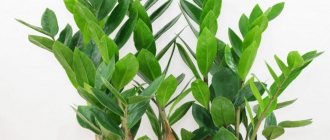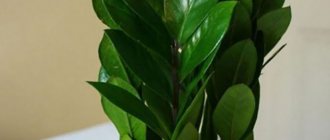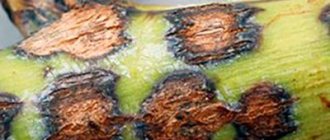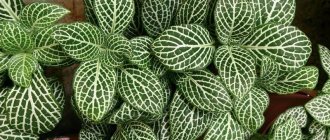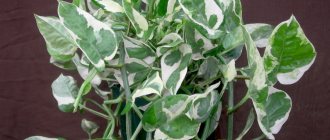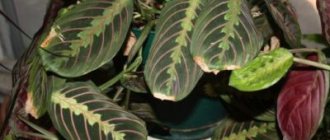Zamioculcas relatively recently, only 10–15 years ago, became known to Russian flower growers. But during this time he gained wide popularity. The dollar tree, also called Zamioculcas, is famous for its very good health and undemanding character. It is recommended to grow it for beginners or lazy gardeners. However, even the most unassuming plant can wither and begin to lose yellowing leaves if you constantly violate the rules of care. Therefore, you need to know how not to make Zamioculcas sick and what to do if he does get sick.
Content
- Yellowing of the lower segments of leaves Symptoms
- Cause
- How to water correctly
- Symptoms
- Symptoms
HerrWick/Flickr.com
The popularity of zamioculcas , or dollar tree, is growing and growing. And along with it, problems associated with improper care of this plant also grow. What could be happening, what are the reasons , and how to correct the situation? It is these moments that we will consider.
Jürgen Diermaier / Personal archive
Yellowing of the lower leaf segments
Symptoms
Individual leaf blades (component parts) turn yellow and fall off, starting from the bottom of the complex leaf of the plant.
Cause
The most likely reason is regular waterlogging of the soil . It is worth reviewing the watering regime , otherwise the process may become irreversible and you will lose the entire plant. Zamioculcas is a succulent that stores water for future use in almost all its parts, so it does not need excess moisture .
Wendy Cutler / Flickr.com
How to water correctly
In winter, watering is very moderate , especially if the contents are cool (less than +15 ° C). In summer, watering needs to be increased slightly , but the soil in the pot should always dry out 2/3 of the volume between waterings.
- It is very important to select pots that match the size of the plant's root system and suitable soil that drains moisture well. And never leave water in the pan for zamioculcas!
Forest and Kim Starr / Flickr.com
Reproduction methods
Zamioculcas can be propagated in several ways:
- sheet plates;
- separate leaves.
Reproduction by plates
To propagate the plant, you should select a well-developed, middle-aged leaf blade and carefully divide it into several cuttings so that each of them has several leaves.
After dividing the leaf blade into cuttings, they must be left in the air for several hours.
The end of each branch is necessarily treated with activated carbon. This will help stimulate root growth. You can also use purchased products for these purposes - Zircon or Kornevin.
To grow cuttings, you should use light soil with the addition of vermiculite, which will make the soil more loose.
To speed up the rooting process of cuttings, they can be covered with glass or film.
The first time the sprouts will need to be watered only three days after planting. This should be done carefully: lightly spraying the soil with a spray bottle.
Within approximately 1-1.5 months, tubers with roots will appear on the cuttings. In the next 5 months, the first leaves will begin to develop on young plants.
After the root system has grown well and the leaves have become stronger, the young plants can be transplanted into a new pot.
Propagation by leaves
This method involves separating several individual leaves from the leaf plate. The leaves should be left in the open air for several hours. This is necessary to ensure that the cut area is completely dry.
The underside of the leaves must be treated with a root development stimulator.
In order for the leaves to take root, they are laid out on a moist substrate consisting of equal parts of sand and peat. Glass or film is placed on the pot to create a greenhouse effect.
Before the first shoots appear, it is not recommended to ventilate the room.
You can plant leaves without a greenhouse. For these purposes, use ordinary soil for zamioculcas, into which the treated leaves are carefully placed. Two days after planting, the soil must be carefully moistened.
In about a month, you will notice the first tubers on which roots will begin to form.
The plant can also be propagated in water using individual leaves. The main thing is to treat the cut site with means to stimulate root formation.
Falling leaves
Another reason for yellowing of leaves and their falling can be cold air or too sudden temperature changes in winter, especially if the plant is standing on the floor.
It happens that during the day the house is very warm (in sunny weather, for example), and at night the temperature drops sharply. excessive changes are harmful for any plant . It is better if the room is either consistently cool or consistently warm.
- Sudden changes in temperature or light levels can also cause suddenly rather than gradually .
Forest and Kim Starr / Flickr.com
Softening tissue
Symptoms
Branches (compound leaves ) become soft at the base , leaf blades and thickened petioles rot .
Cause
The most common reason for this condition of the dollar tree is, again, a violation of the watering regime . Excessive watering, waterlogging of the soil and water standing in the pan are the main causes of the problem , especially if this happens indoors in winter at unfavorable temperatures (too cold or too warm).
soft black spots appear on the leaves (not to be confused with the natural “spotty” color of the petioles), then this also tells us about excessive watering.
marijana1 / Personal archive
Transfer
Zamioculcas is replanted as the root system grows in the spring and summer after about 2-4 years. If desired, you can speed up the growth of the plant; To do this, it is transplanted annually into a wide and tall pot.
For good growth, zamioculcas need a mixture made up of equal parts of sand, turf and leaf soil. To improve the soil structure, you can add a little peat or chopped sphagnum. If desired, you can purchase a ready-made earthen mixture for cacti in the store. Zamioculcas is undemanding to soil composition, but clay, pure peat or rich humus is not necessary. But good drainage is very important (at least 1/4 of the height of the pot) to prevent root rot.
To plant zamioculcas, initially use a medium-sized pot. Subsequently, the plant is transferred without disturbing the earthen coma into a new, larger pot, where fresh soil is added, taking into account its capacity. Zamioculcas takes a long time to get used to a new place; will begin to grow actively only when its roots reach the walls of the pot. When transplanting tubers from a plant, it is not recommended to go deep into the ground.
When replanting a plant, flower growers often use gloves: the sap of the plant is poisonous. For grown Zamioculcas leaves, a support with rings is often used, otherwise they may begin to collapse.
Leaves turn pale and stretch out
Symptoms
Young shoots are too long, elongated (the internodes between the leaf blades increase significantly), pale , often underdeveloped and weak.
Maja Dumat / Flickr.com
Cause
Since Zamioculcas is a generally very patient and hardy plant, the reason for this condition can only be a combination of several factors .
Too indoor air in winter lack of minimally adequate lighting during the period of active growth, excess nitrogen fertilizers and excessive watering . The problem lies in the combination of several or all of these factors at once.
- As a rule, this happens in winter or early spring , when the plant should be kept cooler (+16-18 ºС), and watering should be more than moderate.
- If this happens during a period of active growth , then the reason may be a lack of nutrients or very poor lighting .
pxhere.com / Personal archive
Table: care errors, main diseases, pests
| Symptom | Feature of the plant | Care error | Disease | Pest |
| Zamioculcas leaves turn yellow | If there is young growth, there is nothing to worry about. Over time, the old leaves die off. Delete them | Low temperature or waterlogged soil | Root rot | |
| Drops of water appear along the edges of the leaf blades (zamioculcas “cries”). | For aroid plants, which include Zamioculcas, this is the norm. This is how the plant reacts to rainy weather: when the surface of the leaves cannot cope with evaporation, then special ducts open - hydriators | Reaction to high air humidity or soil flooding. | ||
| The plant does not produce new shoots and grows slowly | Zamioculcas grows 2-3 leaves per year - this is the norm | Lack of light. The pot is too spacious, the plant grows a tuber. | Deficiency of microelements: nitrogen, fluorine, copper, molybdenum, boron, chlorine, iodine. | |
| There are dark, softened areas on the tuber and roots | Low temperature and waterlogged soil. Heavy soil | Root (tuber) rot | ||
| There are dark spots on the petioles | Dark green spots appear on the petioles of mature leaves | Unhealthy wet spotting is a consequence of low temperature, excessive watering | Various types of rot or spotting, damage by viruses or bacteria | Defeat by scale insects |
| The petioles are wrinkled, the feathers are drying out | Insufficient watering if the petioles are hard and dry | Root rot if tissues are soft | ||
| The petioles are thin, droop and fall off | Nutrient deficiency | |||
| The edges of the leaves dry out and curl | Dried soil. The air is too dry due to the proximity of heating devices. Sunburn | If a white web is visible, it is a mite infestation | ||
| Leaves lose color, become lighter, turn pale, white spots are noticeable | Chlorosis is a disruption of the process of photosynthesis. Infectious chlorosis is caused by viruses and fungi | Carriers of chlorosis - aphids and mites | ||
| Zamioculcas sheds leaf segments | Reaction to stress from transplantation, cold water | Nutrient deficiency | There are colonies of small insects on the plant - aphid infestation | |
| Hard brown scutes on the leaves, the plant loses its vigor | Defeat by scale insects | |||
| New shoots dry out, the plant has stopped growing | Drafts, watering with cold water | Root rot | ||
| Zamioculcas has become reddish or orange in color | Reaction to changes in lighting. Lightening or redness is caused by too much light | Yellow or brown color - possible rot, bacterial or viral disease | ||
| The bases of the leaves thicken | This is a natural phenomenon; moisture accumulates in the thickenings of the petioles | |||
| The plant dries out. Zamioculcas tuber became empty | Fomoz, or dry rot | |||
| Zamioculcas fell apart, the leaves turned black | Waterlogging of the soil, not enough light | Root rot. Fungal disease - niello | ||
| Sticky drops and whitish, cotton-like lumps appeared on the leaves. The leaves are withering | Mealybug | |||
| Brown wet coating on the petioles, they soften and die | Waterlogging of the soil in combination with low temperatures | If the tissues are softened, this is stem rot, which is caused by a fungus | ||
| The leaves are stretched, the number of leaf blades is reduced, they become paler | Lack of lighting | There is not enough fluorine, and possibly other elements | ||
| The plant is not developing well. Whitish small insects are visible in the soil | If the insects are jumping, they are fools. If black or gray midges are flying around, and pests in the soil resemble worms, these are fungus gnats |
The plant has become thinner
The leaf blades have become thin , and the previously fleshy leaf petioles have become very wrinkled .
How long have you been watering the plant? If its leaf “bottles” have also shriveled, then, for sure, you have managed to dry even zamioculcas. The plant survived on its succulent properties and most likely gradually depleted its reserves of moisture , set aside for a rainy day.
- Resume watering , only a little and gradually . Soon the plant will fully recover.
Krzysztof Ziarnek, Kenraiz / Personal archive
Zamioculcas stopped growing
Zamioculcas is generally a slow-growing plant, and if it does not show signs of growth in winter , then this is normal and is no need to worry until spring
If this happens during the period of active growth (from spring to autumn), then the cause may be a lack of nutrition or a too cramped pot.
- In such a situation, the plant needs to be replanted , moved to a brighter place and, after a month or two, begin regular feeding . And Zamioculcas will definitely give you new shoots.
Mr.Rosewater / Personal archive
When is there no reason to worry?
Zamioculcas can hurt in different ways; its leaves turn yellow when the flower is old enough. In such a situation, usually the old sheet plates are replaced by new ones. In this case, there is no cause for concern, since this is a normal process caused by natural factors. This is the rejuvenation of culture. Since the growth of the flower itself is quite slow, the change of leaf blades often takes longer.
What to do if the zamioculcas stem has shriveled, and dark spots or real stripes have appeared? Worry in this situation is often unfounded. If there are no traces of the presence of pests and no putrefactive processes are observed, then there is no need to worry. Often this is how the decorative individuality of a plant is manifested.
The main point of growing
Zamioculcas usually grows and develops without problems. This is one of the most unpretentious plants in the world. It is suitable for everyone , even the most inexperienced and novice flower growers. Zamioculcas should not be planted only by those gardeners who love to water their plants too much.
- The main reason for its poor health and death is precisely incorrect, excessive watering . regulates the amount of moisture for the time being , storing it in its leaves and tuberous rhizome, and then begins to “ signal .” If the plant is bad and it is dear to you, then it needs help .
Mokkie / Personal archive
Ambulance for Zamioculcas
At the first painful signs of waterlogging, stop watering the plant . Allow the soil to dry completely and the plant to recover. However, if you see that Zamioculcas is only getting worse , proceed to “ rescue measures .”
- Remove the plant from the pot.
- Rinse the root system with water. Inspect and feel the roots and tubers.
- Cut out all rotten areas with a sharp knife to healthy tissue and sprinkle the wounds with crushed charcoal (activated charcoal .
- Place the plant on paper and let it dry for several days.
- If you plan to plant zamioculcas in the same pot , wash it with a brush and soap and disinfect it .
- Get fresh succulent soil . Place a drainage layer of 2-4 cm at the bottom of the pot, depending on the height of the dish and the plant itself.
- Plant zamioculcas in fresh soil. Place it in the same way as it grew before, without deepening it .
- Place the pot in the brightest place in the house, protected from midday direct sunlight at first.
- After planting, do not water Zamioculcas for 3-4 days. Then start watering little by little , lightly moistening the top layer of soil. If signs of the disease no longer appear, start watering the plant a little more, but also very sparingly.
- Do not feed the transplanted plant for 1.5-2 months.
Andreas Hammerschmidt / Personal archive
If the rotting of the plant turns out to be too severe , you can try to save it by taking cuttings from the remaining healthy parts. For these purposes, a whole leaf, any fragment of it, or even a separate leaf blade is suitable Be patient - the process of propagating zamioculcas by cuttings is quite lengthy .
And do not forget that the plant is poisonous (like many representatives of the Araceae family), it is advisable to carry out all work with it wearing protective gloves .
Description
The Zamioculcas flower is a member of the Araceae family. This genus is represented by only one species with subspecies. To date, several additional subspecies have been bred, one of which is, for example, the lanceolate plant (Z. Lanceolata).
Zamioculcas got its name due to the fact that the shape of its leaves is very similar to the leaves of zamia, a plant native to the African continent.
The leaves of the flower have a green color and a glossy surface. There can be about 10 feathers on one sheet.
The dollar tree is a low-growing herbaceous plant with tuberous roots. Most often, Zamioculcas grows no higher than one meter.
The plant is well adapted to drought. It accumulates water in the center of the stem. If a flower does not have enough water, it sheds its upper leaves - this leads to a decrease in the intensity of moisture evaporation.
The indoor plant blooms extremely rarely. When flowering, a short and thick peduncle with an inflorescence is formed on the bush, resembling the shape of an ear of corn about 8 cm long. This ear has a light beige color.
The leaves contain poisonous juice, so when replanting the plant, it is necessary to wear gloves.
There are a lot of rumors around Zamioculcas... For example, some people think that a money tree can make its owner richer, but to do this, you need to treat the plant the same way as a family member; you need to have conversations with it while watering.
It is necessary to ask the plant for financial well-being on Tuesdays during the waxing moon. Moreover, it is recommended to tie a dollar bill rolled into a cone like a pyramid to a zamioculcas leaf.
According to the teachings of Feng Shui, a tree pot located in the southeastern part of the house will bring financial well-being to its owner.
Many plant lovers believe that watering should only be done with special “money” water. It’s easy to do – you just need to pour a few coins in any container with plain water and wait a couple of days.
If someone gives you a money tree, give that person a few coins in return - this will also promote good luck.
It is believed that Zamioculcas is capable of connecting two people. To do this, it must become a gift to a woman from a man.
But besides wealth and love, the flower is also capable of carrying diseases. It is believed that if it fades, disaster awaits. In this case, you must immediately give the neighbor’s sick plant a gift - just buy another flower, but only a healthy one. Then the fading money tree will recover and everything in the house will return to normal.
There are also rumors that as long as there is a zamioculcas in the house of a lonely lady, she should not expect love. A jealous plant will not allow itself to be replaced.
One way or another, it’s up to you to decide whether to believe or not in such beliefs.
